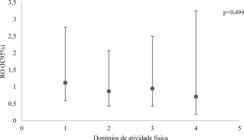Abstract
The scope of this paper was to verify the association between the practice of physical activity of different types and the use of insulin in adults and the elderly. This is a cross-sectional population-based study with data from the survey entitled Surveillance of risk factors and protection for chronic diseases by telephone (VIGITEL 2013). The sample consisted of individuals aged ≥18 years, living in the 27 Brazilian capitals and diagnosed with diabetes. The practice of physical activity in commuting, the home, leisure, work and the use of insulin were self-reported. Binary logistic regression was used in crude and adjusted analyses for sociodemographic factors. Of the 4,593 subjects with diabetes, insulin use was reported by 16.2% and 25.5% of adults and the elderly, respectively. The practice of physical activity in the home (OR: 0.61, 95%CI: 0.40; 0.94) and at work (OR: 0.38, 95%CI: 0.18; 0.78) were associated with the lowest use of insulin among the elderly. There was a tendency to reduce insulin use as the number of physically active domains increased among the elderly (p = 0.003). The conclusion drawn was that physical activity practiced alone or in a cumulative way in different domains was associated with lower insulin use among the elderly.
Key words
Medication; Diabetes mellitus; Motor activity; Cross-sectional studies

 Thumbnail
Thumbnail
 Thumbnail
Thumbnail

